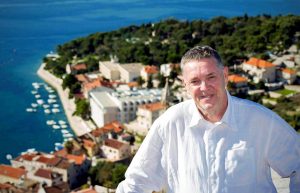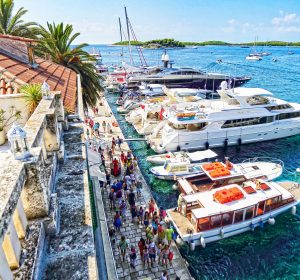We have the challenge to regulate the town to fit its population, their needs and wishes, and only after we do that, we can be in service of tourism. In this, we also want to keep the distinctive style that makes us appealing to tourists with a sophisticated taste for culture and gastronomy.
“Back in the day, the island of Hvar used to be compared to Saint Tropez, and today it is compared to St. Moritz. However, in order to maintain its position of a prestigious tourist destination, the island needs to nurture its uniqueness that is based on the rich cultural heritage, exceptional gastronomy and an attractive offer of active and nautical tourism,“ says Rikardo Novak, the Mayor of the town of Hvar and adds:“We do not want to be recognized solely as a party destination which is why we have been actively changing the paradigm of tourism that we want to promote.“

Foto: Grad Hvar / Cropix
1. Some islands are among the wealthiest local self-government units in Croatia, and yet many are suffering from depopulation. How are these challenges reflected on Hvar?
Although in terms of budget revenue and expenditure per capita, the town of Hvar is classified as one of the wealthier local self-government units, that does not mean that is immune to negative demographic trends. Unfortunately, people are under the impression that our town lives only during the tourist season which is why we have a challenge ahead of us to regulate the town to fit its population, their needs and wishes, and only after we do that, we can be in service of tourism.
It sometimes happens that, post-season, people shut down their catering facilities, souvenir shops and stores and that Hvar resembles a ghost town. This is understandable to a certain degree because there are high business costs that make the year-around operations unprofitable, and, after all, people need to rest after an exceptionally exhausting and intensive tourist season. Therefore, we should strive for sustainable tourism that would be dispersed throughout the year and thus would alleviate the six-month-long high season. If we did this, the town would have the necessary content that would classify it as an urban unit during the winter too, which, in turn, would keep the existing population on the island.
2. For the first time in history, the Croatian government held a session on an island last year, and that island was Hvar. The session was dedicated to development policies on islands and tourism. What lessons have you learned from it and what kind of development policy do you consider to be the best for Hvar?
I must admit that I am proud of the fact that a government session was held for the first time ever on an island, and that Hvar was picked for that during the term of an independent mayor. This points to the fact that Prime Minister Plenković’s government is interested in islands, as well as in different political options. As far as the development policy is concerned, the fact that the town of Hvar belongs to the 8th group of local self-government units which, according to the index values, are considered the above-average units of local self-government, our prospects when applying with projects are significantly diminished.
However, I am pleased to see that, thanks to the new law, islands are classified as a separate category which opens up for us different opportunities when submitting and later implementing our projects. I think that Hvar, as an island, should breathe as one. I am also exceptionally glad to see that four of our local self-government units, during this term in the office, have established fantastic cooperation which means that, with synergy and responsible and sustainable development, we can embark on developing both the island and the town of Hvar.

3. You were quoted as saying that Hvar „is the St. Moritz of Croatian tourism“. What kind of tourists would you like to see here?
I compared Hvar to St. Moritz due to the fact that St. Moritz is the destination of choice for well-to-do guests with a developed sense of culture, gastronomy and propensity for polite fun. Hvar has all the predispositions to be St. Moritz of our tourism. Otherwise, parallels with the world-famous destinations are nothing new. It is well known that Hvar has been called „the Adriatic St. Tropez of the 20th century“, and that it has been strongly associated with Ibiza in recent times. However, I think that Hvar has to maintain its uniqueness, based on its rich cultural heritage (the only island in the world with 6 UNESCO World Heritage Sites), exceptional gastronomy (also included in the UNESCO list) and an attractive offer of active and nautical tourism.
We do not want to be known solely as a party destination and changing the paradigm of tourism is the forte we want to encourage. Last year, the whole world was informed about the penalties for improper behaviour in the city or drinking alcohol in public places and I can say that the first season saw positive shifts in regard to this. It is still not at the level we would like it to be, but we are working very hard on this issue, and I do believe that the results will soon follow.
4. Last year, you celebrated 150 years of tourism in the town. Is this a Croatian, European or global story?
This is definitely a global story that has helped Croatia position itself as a tourist destination in Europe, as well as in the world. The Hygienic Society was founded in Hvar in 1868 which was the forerunner of the tourist communities we know today and that is why the emphasis was on celebrating 150 years of organized tourism in Europe. Also, this year, we opened the oldest public theatre in Europe, built in 1612, after nearly two decades of reconstruction, which again puts us at the centre of the international public interest. We have proven that even a mention of Hvar opens many doors, but it also comes with the responsibility of making sure that this gem of an island continues to shine and progress.
5. How did this experience affect the town and its development? What development trends are created as a result of the changes in the nature of tourism and new demands by tourists?
As the pioneer of organized tourism in Europe, the town of Hvar developed together with this economic branch which, in a way, mitigated an aggressive impact that tourism often has in the destinations that are not entirely ready for it.
Our ancestors actually practised sustainable tourism even before it became a global necessity, and we are grateful for that. We have retained our island identity, our culture and heritage in many segments. In a very short period of time, new trends have brought about significant changes – tourists stay for a shorter amount of time and during this short stay they want to experience as much as possible; everything has become more intense and not everyone is able to deal with it.
The town of Hvar has adopted its development strategy. We are also currently writing a tourism development strategy and this new wind to our sails and the new direction that we are taking give us hope that the 150th year of organized tourism was also the pilot year for Croatian tourism. The pilot year in a sense that we are again focusing on the best and the most valuable things that Hvar has to offer with the view of preserving and improving it. We have already launched projects of the construction of a sports and health centre. We see the future of culture as an important part of our identity as witnessed in the implementation of the “Hvar – Fortress of Culture” project, during which we will restore our historical monuments and create new cultural and tourist products with the help of the EU funds.
6. What, on the other hand, do these tourism plans mean for the population of Hvar? Do they generate higher prosperity or costs that cannot be sustained?
The role of the town, as a local self-government unit, is to use its infrastructure, projects and strategic plans to ensure a comfortable life for its citizens and an equally comfortable stay for its guests. This can be achieved only through the synergetic cooperation between the town, the tourist board, companies and the citizens, which keeps getting better year-on-year.
7. How much money does the state invest in the development of port and transport infrastructure? How can these investments ensure a more balanced development of the island?
The challenge in developing our islands lies in the decentralization of these resources, and the fact that the port and transport infrastructure has not been developed in line with the needs of particular local communities. We have seen significant changes recently in the town of Hvar. The historic Mandrać Port has been restored, the port’s operational coast has been extended, and transport connections are beginning to be adjusted to the demands of tourist season. Although these are still small steps compared to our needs and our contribution to Croatian tourism and economy, we are working on improving cooperation at the national level, especially on increasing the number of transport links and building the necessary infrastructure.